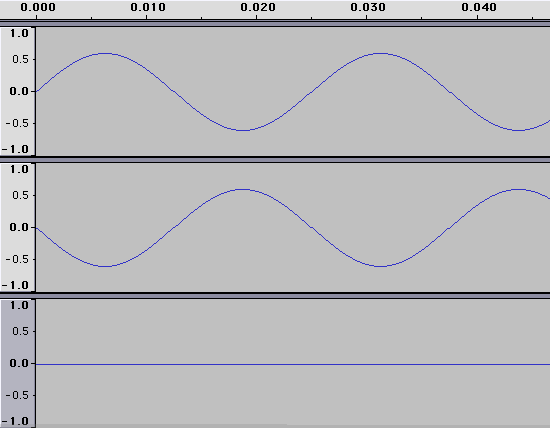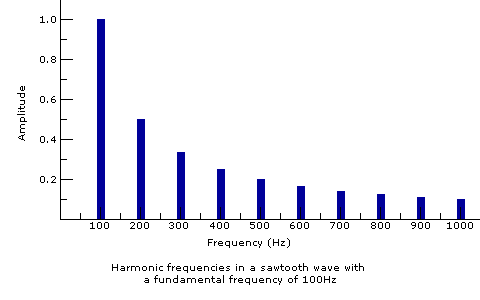Lära sig att skapa egna leads. (MYCKET TEXT!)
Well here it is - the synthesys basic:
With this covered, you will be able to create any leads, plucked, bass you immagine. So sit back cuz this might take a while.
_______________________________________________________________________
Sound waves and oscillators
Sounds are pressure waves which travel through air, or another medium, to our ears. Unlike waves in the ocean, which move up and down, pressure waves move forward and back. These waves move our ear drums in and out, and we experience this as sound. Sound synthesis is the art of creating signals that, when turned into sound waves by a speaker, people find interesting. During the course of this article we'll explore a number of devices that create and modify signals used to synthesize sound.
The first such device we'll consider is called an oscillator. An oscillator generates a consistent, repeating signal. Signals from oscillators and other sources are used to control the movement of the cones in our speakers, which make real sound waves which travel to our ears. If you tie one end of a rope to a doorknob, stand back a few feet, and wiggle the other end of the rope up and down really fast, you're doing roughly the same thing as an oscillator. The difference is that you're wiggling a rope, whereas the oscillator is wiggling an audio signal.

Audio signals are often represented on a graph where the horizontal x-axis represents time and the vertical y-axis represents the pressure of the signal. This is called a time domain representation of audio. Time domain graphs are kind of like instructions for speakers about how to move in and out. When the graph reads 1, the speaker cone is pushed all the way out, when it reads -1, the cone is pulled all the way in. This movement creates a pressure wave in the air which we hear as sound. If a speaker cone moves in and out according to the graph above, it will make the sound of a bass drum.
Frequency and pitch
The rate at which a sound wave moves in and out is called the frequency. Frequency is measured in cycles per second. The length of a singal cycle of a waveform is the span of time it takes for that waveform to repeat. People generally hear an increase in the frequency of a sound wave as an increase in pitch. When the frequency of an oscillator is doubled, the pitch of the sound it generates moves an octave up. For example, an oscillator generating a signal that repeats at the rate of 440 cycles per second will have the same pitch as middle A on a piano. An oscillator generating a signal that repeats at 880 cycles per second will have the same pitch as the A an octave above middle A. A common way of saying "cycles per second" is "Hertz," abbreviated "Hz."
Basic waveforms
There are four different types of basic wave shapes, or waveforms, illustrated here.
Technical note: Topics in music synthesis sometimes call for a little bit of math. If you're not a math person, that's okay, you can skip over the stuff that doesn't make sense. To make it easier for you, the parts you can skip will be safely contained in these sturdy boxes.
Sine
Audio example of sine waves. http://beausievers.com/synth/synthbasics/audio/sinewave.mp3
Sine waves look similar to a gentle wave in a bowl of water, moving up and down with no abrupt starts or stops. Common sounds similar to a sine wave include whistling, air blowing across the opening of an empty bottle, and a ringing tuning fork.
Technical note: The sine wave is the most basic, pure waveform, with a contour described by a trigonometric function called the sine function. Any other waveform, including the other simple waveforms described below, can be created by adding up a series of sine waves. Details on this process exceed the scope of this article. For more information, check out the Wikipedia entries on Fourier Analysis and Additive Synthesis.

In the above picture, the first two sine waves are added together to produce a third, different wave.

In the above picture, a sine wave is added to its opposite. The result is silence.
http://beausievers.com/synth/synthbasics/i/sineharmonics.png
The above chart represents an audio signal based on its frequency. This is called a frequency domain graph. Some stereo systems have an LCD screen where lines rise and fall based on the pitch content of the sounds being played. That LED screen is a frequency domain representation of the audio. As shown in the chart above, a sine wave would only push up one of these lines. This is because sine waves, the simplest waves, have only one frequency. More complicated waves can have energy at more than one frequency, and a graph is a good way to keep track of what's going on. We'll look at frequency domain graphs of more complicated waves very soon.
1) SAW or Sawtooth
Example: http://beausievers.com/synth/synthbasics/audio/sawtoothwave.mp3

Sawtooth waves, also called saw waves, have a very strong, clear, buzzing sound. A sawtooth wave can be made by adding a series of sine waves at different frequencies and volume levels. The frequency of the first, loudest sine wave is what we hear as the frequency of the resulting sawtooth. This is called the fundamental frequency. Each of the other, progressively quieter, sine waves that make up a sawtooth have frequencies which are integer multiples of the fundamental frequency. These frequencies are called harmonics.
For example, an ideal sawtooth wave with a fundamental frequency of 100Hz would have harmonics at 200Hz, 300Hz, 400Hz, and so on to infinity, with each harmonic quieter than the last. Because the sawtooth wave contains every integer harmonic of the fundamental frequency, it sounds very rich to our ear. The fundamental frequency defines the pitch of the sound, while the harmonics change the character, or timbre, of the sound without affecting the pitch.
Technical note: The amplitude of a given harmonic in a sawtooth wave is equal to the inverse of its harmonic number. For example, a sawtooth wave with a fundamental frequency of 100Hz and an amplitude of 1 would have a harmonic at 200Hz (100*2) with an amplitude of 0.5 (1/2), another harmonic at 300Hz (100*3) with an amplitude of 0.33 (1/3), and so forth. The more harmonics are added in this manner, the more the wave will look like the idealized sawtooth wave depicted in this article.

RIktigt bra och läsvärd text för de som skapar egen musik! Tackar och bockar för denna texten, ska nu prova mina nya kunskaper lite. :)
Vem är det som skrivit allt det där? Det är inte du va?
behöver inte detta, jag är bäzt redan, visst henke?
jag kan inte få madtracker att göra ett pip ens....
kan inget om era hippa förkortningar och idéer om att vara riktiga musiker X_X
Burzum, vi skiter i vare sig du tycker att musik gjord i datorn är musik eller inte. I slutändan är det ljudvågor vi snackar om ändå.
Rensar bort inlägg.
Umm skulle vära GROVT tacksam om du kunde göra en Tutorial på utube om det här :D!
Det skulle jag med vara! :D
detta är ju ingen tutorial om hur man gör en lead, det här beskriver bara vad sakerna du använder för att göra en lead är för något
Underbart tack!
Citat från jebac
detta är ju ingen tutorial om hur man gör en lead, det här beskriver bara vad sakerna du använder för att göra en lead är för något
Precis, men när man kan detta så kan man göra ett lead. Alltså är det en grund till att skapa egna leads. ^^
äntligen en bra tråd!<3
Citat från December
äntligen en bra tråd!<3
Antar att du inte förstod någonting eftersom att du var tvungen att lägga till ett "<3" efter.
Citat från Hypothermie
jag kan inte få madtracker att göra ett pip ens....
Madtracker är ju härligt... byt DAW... Det är 2012...
Du måste vara inloggad för att skriva i forumet